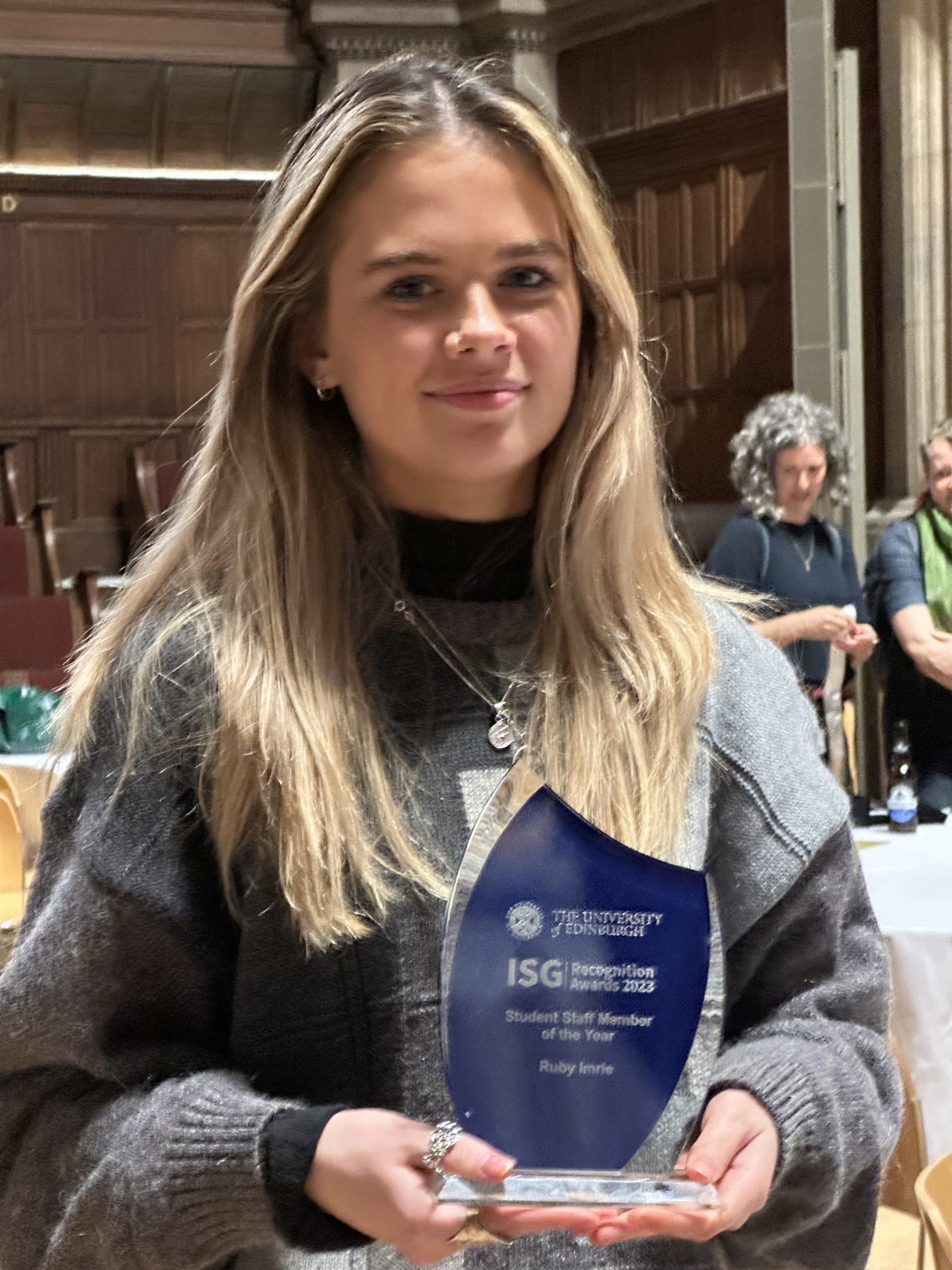 3rd year Computer Science student, Ruby Imrie, has just won Student Staff Member of the Year at the 2023 University of Edinburgh’s ISG (Information Services Group) Staff Recognition Awards on Tuesday 24th October 2023. As a central support service for the University and one of the largest tech employers in Scotland, and with over a hundred student workers being employed each year, this a real celebration of the work Ruby has been doing in opening up research datasets and helping people around the world understand what happened in the Scottish witch trials.
3rd year Computer Science student, Ruby Imrie, has just won Student Staff Member of the Year at the 2023 University of Edinburgh’s ISG (Information Services Group) Staff Recognition Awards on Tuesday 24th October 2023. As a central support service for the University and one of the largest tech employers in Scotland, and with over a hundred student workers being employed each year, this a real celebration of the work Ruby has been doing in opening up research datasets and helping people around the world understand what happened in the Scottish witch trials.
Ruby has worked for us full-time from Monday 5th June until Friday 25th August 2023 in the role of Witchfinder General: Data Visualisation intern and has happily agreed to continue working one day a week during her studies from 14 Sept 2023 until May 2024 to complete her exemplary work as there is always so much more to do.
Ruby has worked incredibly hard to help illuminate what happened in the Scottish witch hunts of 1563 to 1736 by focusing on opening up the rich historical data in the University’s landmark Survey of Scottish Witchcraft database (an MS Access 97 database created in late 1990s and completed in 2003) and turning it into linked open data in Wikipedia’s sister project, Wikidata, a knowledgebase of structured linked open data.
Importantly, Ruby has been quality checking and consistency checking the data using newly developed quality assurance methods in R Studio created by another student intern, Claire Panella, earlier this year that can be reused for many years to come. Ruby’s other focus has been on taking the extremely rich) data on all the 3,816 full witchcraft investigations (encompassing the initial or supposed denunciation, the arrest, the interrogation, the trial and the recorded trial outcomes) recorded in Scotland from 1563-1736 and embedding those new interactive visualisations on our Map of Accused Witches in Scotland website using a Javascript and the Vue.js framework. By also identifying and addressing bug fixes, conducting rigorous user testing sessions and using the feedback received to address areas for site improvement and action planning for developing new features she has helped to show how the data, and the individual human stories behind the data, can be better visualised, explored and interrogated as never before.
Ruby has also taken a personal interest in learning more about the Scottish witchcraft panics by attending talks about Scottish witches at the Edinburgh Book Festival 2023, reading the Jenni Fagan book, Hex, and attending the play, Prick, at the Edinburgh Fringe. She has also contributed blog articles documenting her work so that anyone can understand the variety of skills she has had to learn and then build from her prior learning.

Ruby Imrie and Professor Julian Goodare, Project Director of the Survey of Scottish Witchcraft at University of Edinburgh Library 23 August 2023
The work above shows the sheer variety of technical and analytical skills she had to employ. Attention to detail has been paramount so that the data was never misunderstood or misrepresented. Ruby analysed the original MS Access 97 database (2003), exported its contents in bespoke Access queries and .csv forms, manipulated and processed the data using Sparql, Python and R Studio which she had to first learn how to use, created a video about her work, learned new web developing skills using Javascript frameworks she was hitherto unfamiliar with, collaborated with developer colleagues, Wikidata experts, historian colleagues and other interns.
She has been enthusiastic both about learning technical skills and really motivated to learn about the Scottish witch hunts (even devouring books about it in her own time). Ruby took ownership and responsibility really seriously to represent the data correctly and the need to help public understand about how these women were persecuted. A seriously hard worker who takes her work seriously… but also an incredibly sunny and personable team player who always asks the right, most pertinent questions of the work in order to progress it in the right way. Which in of itself is really impressive to see in such an early career colleague. Ultimately, she’s analysed, curated and quality assured a VAST amount of data in Wikidata about the Scottish witch hunts in a short Summer internship and worked independently much of the time to do so. She has been an extremely dedicated, constructive and collaborative colleague to work with and has also contributed vastly to discussions about the future of the site and what that should be. So having this opportunity to celebrate and acknowledge her work, and the work of all our past student interns and developer colleagues is a wonderful thing to see.
Especially because we are working hard and not far away at all from launching version 2.0 of our Map of Accused Witches in Scotland website and the new elements will include:
- Rich historical data on all the 3,816 witchcraft investigations in Scotland including:
- Dates of investigations (filterable into panic and non-panic periods of time).
- The primary and secondary characteristics of investigations
- Who the people investigating were – judges, expert witnesses, prosecutors etc.
- Accusations of shape-shifting: “the magical transformation of a human into an animal. This was mainly a popular belief, but educated demonologists accepted it. In the Scottish witch trials, some accused witches confessing to having taken animal form, presumably through coercive interrogation. Less often, neighbours or victims testified that they had seen the witch in animal form. The animal was most often a cat, but we also find transformations into a dog, a ‘corbie’ (raven or crow), or other creatures. For more information about the shape-shifting terms mentioned below please refer to the Survey’s glossary of terms here: https://witches.hca.ed.ac.uk/glossary/”
- Accusations of the ritual objects supposedly used by accused – “Two different types of rituals appear in accused witches’ records. First, there were real rituals, mostly carried out by magical practitioners, for healing and other beneficial purposes. Second, there were imaginary rituals, which the accusers thought that witches carried out when they met the Devil; accused witches were forced to confess to these under torture. Each type of ritual could use magical objects. Thus, a ‘belt’ or a ‘sword’ could be used in healing rituals, whereas ‘corpse powder’ appeared in confessions to demonic rituals. For more information about the ritual objects mentioned below please refer to the Survey’s glossary of terms here: https://witches.hca.ed.ac.uk/glossary/“
- A customisable timeline with slider option and calendar style layout option.
- Select all/deselect all filter options.
- A modern map layer and a 1750 historic Dorret map layer from National Library of Scotland.
- A ‘name search‘ option in the Histropedia timeline so you can type in the accused name and read their Wikipedia page and Survey of Scottish Witchcraft page.
- Age of accused (where recorded) filter in our new Histropedia timeline feature.
- All the unnamed accused witches on the Histropedia timeline.
- Who named/denounced who and a network analysis over time.
- Details of supposed witches’ meetings (locations and how they meetings were characterised and what supposedly happened at them)
- Types of pacts with the devil – “Descriptions of meeting the Devil and entering a pact with him feature in the majority of records that have detailed information. This relationship with the Devil was crucial to the church and the law in proving someone was guilty. 90% of those whose records show demonic features were women. Many people were tortured into confessing to Devil-worship. For more information about the types of pact please refer to the Survey’s glossary of terms here: https://witches.hca.ed.ac.uk/glossary/”
- Types of property damage supposedly caused by the accused.
- A new contact form so anomalies and suggestions can be reviewed and addressed.
- A new map of witch memorials and sites of interest (coming soon) – being collated and illustrated with images and links.
- A Curious Edinburgh tour of Edinburgh locations associated with the Scottish witch trials. (coming soon) – more research to be done.
Year on year, we are building on the work that has gone before and striving to respect and honour the legacy of that work with the human stories of the accused women always at the heart of what we do. Our ‘Witchfinder General‘ student interns in 2022 (Maggie Lin and Josep Garcia-Reyero) added so much data on the witchcraft investigations and now Ruby Imrie in 2023 have helped to turn this data into something quality assured, parseable and implementable on our website: adding dates of witchcraft investigations so we can explore timelines; creating filters to explore individual aspects of the investigations; creating network analyses of who named/denounced who, and demonstrating how the hysteria of the witch trials spread across Scotland in space and time during panic and non panic periods so we can better understand and illuminate this dark period of Scottish history.
If curious about how this all started then you can watch our very first student ‘Witchfinder General’ student intern, Emma Carroll, talking about her 2019 work hunting for the places of residence of all the accused witches in Scotland so they could be geolocated on a map and their individual stories discovered, remembered and brought home to their local communities.




